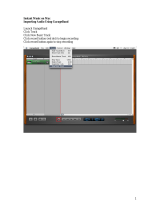Page is loading ...

1
Workshop
M-16DX 16-Channel Digital Mixer
© 2007 Roland Corporation U.S.
All rights reserved. No part of this publication may be reproduced in any form without the
written permission of Roland Corporation U.S.
Apple™ and GarageBand ™ are trademarks of Apple Inc.
Apple Inc. is not associated or aliated with Roland in any manner.
M16DXWS07
Using the M-16DX with GarageBand
™

2
About the Workshop Booklets
The EDIROL M-16DX 16-Channel Digital Mixer delivers the power of digital
mixing to musicians at an incredibly affordable price. This crystal-clear 24-bit
digital mixer supports sample rates up to 96 kHz, and it’s extremely flexible,
with a wide range of analog and digital inputs and outputs, and effects. The
M-16DX’s USB connectivity makes it an ideal partner for a computer-based
digital audio workstation, and features such its pro EQ and the innovative
Room Acoustic Control make it an excellent live mixer as well.
Each M-16DX Workshop Series booklet focuses on one M-16DX topic, and is
intended as a companion to the M-16DX Owner’s Manual.
The M-16DX Workshop booklets require M-16DX O.S. Version 2.00 or higher.
You can download the latest O.S. for free from www.RolandUS.com/EDIROL.
About This Booklet
The M-16DX makes an great companion to a digital audio workstation—or
“DAW”—on a personal computer. To learn the basics of using the M-16DX
with a DAW, see the Workshop booklet Using the M-16DX with a DAW. After
you’ve checked that out, come back here for specific instructions on using
the M-16DX with Apple’s GarageBand™.
We’ll assume you know how to operate GarageBand. To learn about using
GarageBand, consult the built-in documentation in its Help menu. We’ll also
assume the M-16DX is connected to your Mac, and that it’s powered-up.
Understanding the Symbols in This Booklet
Throughout this booklet, you’ll come across information that deserves
special attention—that’s the reason it’s labeled with one of the following
symbols.
A note is something that adds information about the topic at hand.
A tip offers suggestions for using the feature being discussed.
Warnings contain important information that can help you avoid
possible damage to your equipment, your data, or yourself.
Setting GarageBand Preferences
Since GarageBand records only at a sampling rate of 44.1 kHz, set the
M-16DX to 44.1 kHz as described in the Using the M-16DX with a DAW
Workshop booklet.
To configure GarageBand so it’s using the M-16DX for its inputs and
outputs:
From the GarageBand menu at the top of the
1
screen, select Preferences...
At the top of the Preferences window,
2
click Audio/MIDI to open the Audio/MIDI
preferences pane of the Preferences window.
Set both the Audio Output and Audio Input
3
parameters to EDIROL M-16DX 44.1 kHz.

3
After each selection GarageBand asks “Change audio driver?” Click
Yes to proceed both times.
The Audio/MIDI pane should now look like this:
Click the Advanced Tab at the top of the window, and set Audio 4.
Resolution as desired. If you want to
record a CD—
• select Good so that audio is recorded at 16 bits, as
CDs require.
record at higher quality with later conversion—
• select Better to
record at 24 bits, with conversion to 16 bits when it’s exported.
record the highest-quality audio—
• select Best for 24-bit recording
and export for uses other than burning a CD.
Close the Preferences window.
5
Setting Up a Track for Recording
Selecting Audio to Record
Create a new real instrument track.1
Select the Basic Track preset in the Track Info panel.2
After recording, you can select other presets for your track. They’ll
add pre-configured effects to the track, and change its icon.
From the Input Source popup, select what you 3.
want to record from the M-16DX. To record
a mono input channel to which a mic or
•
instrument is connected—select the desired
channel from Mono 1 to Mono 4.
a stereo input channel to which you’ve
•
connected a keyboard or some other stereo
device—select the desired channel from
Stereo 5/6 to Stereo 15/16.
the stereo mix bus—
• select Stereo 17/18.
a pair of mono channels onto a stereo Garageband track—
• select
Stereo 1/2 or Stereo 3/4.
one side of a stereo channel—
• select the desired channel from
Mono 5 through Mono 12.
Only select Input Channels 13/14 or 17/18 when the M-16DX’s USB
button isn’t lit to avoid feedback.
All of the channels have “(EDIROL M-16DX 44.1KHZ)” at the end of
their name. We’ve left out this phrase here just to make things easier
to read.

4
Turning Off Software Monitoring
Set the Monitor popup below Input Source to 1 Off.
As we noted in the Using the M-16DX with a DAW Workshop booklet,
you do have the option of listening through GarageBand if you want to
hear its effects as you record. However, since you’ll encounter latency
doing this, we recommend listening directly through the M-16DX.
Troubleshooting
If you experience problems recording or playing back audio, GarageBand’s
built-in Help provides steps you can take to solve your problem. Search in
Help for “optimize”—the page of steps is called “Optimizing GarageBand
Performance.” In addition to following these steps, raising the Audio Buffer
size in the M-16DX’s control panel may also help, though it may also increase
latency if you’re working with soft synths in GarageBand.
The End
We hope you’ve found this workshop helpful. You’ll find other
M-16DX Workshop booklets available for downloading at
www.RolandUS.com/EDIROL.
/

